Alpine safari: where to spot Switzerland’s ‘big five’ this summer

Off hiking? Spotting Swiss native wildlife is among the many delights of walking in the mountains.
While most people are familiar with Africa’s ‘big five’ animals, you may not have known that Switzerland has its very own ‘big five’.
Here’s what to look out for, and where to find them.
Ibex
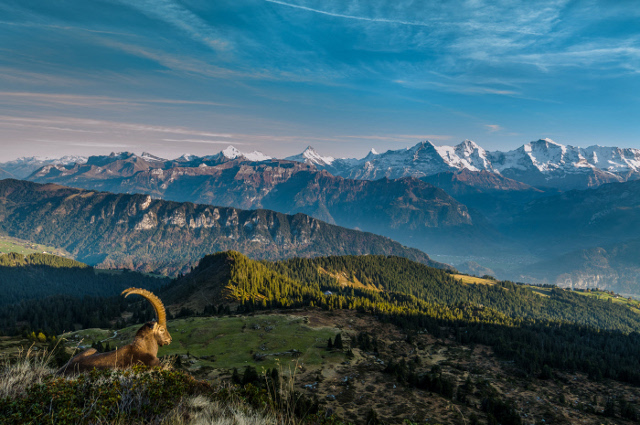 Photo: Martin Maegli/Swiss Tourism
What?
A sort of mountain goat, by the mid 17th century the ibex had been hunted to extinction in Switzerland as their meat and horns were thought to have medicinal properties. Italian king Vittorio Emmanuele III owned a remaining herd but refused all requests from Switzerland to buy some. So in 1906 the Swiss authorities ordered two to be poached from the king’s herd and smuggled across the Swiss border to start a breeding programme. Their offspring were later released into the Swiss National Park.
Both male and female ibex have distinctive horns, though those of a female are slightly smaller. The horns grow a few centimetres a year throughout their whole life, meaning it’s possible to determine how old the animal is by counting the rings on its horns – if you can get close enough, of course.
Where?
There are around 15,000 ibex in Switzerland, mostly in rocky high alpine areas above the treeline. Sure-footed and agile, you might spot them standing on rocky cliffs or negotiating a path that looks impossible.
Chamois
Photo: Martin Maegli/Swiss Tourism
What?
A sort of mountain goat, by the mid 17th century the ibex had been hunted to extinction in Switzerland as their meat and horns were thought to have medicinal properties. Italian king Vittorio Emmanuele III owned a remaining herd but refused all requests from Switzerland to buy some. So in 1906 the Swiss authorities ordered two to be poached from the king’s herd and smuggled across the Swiss border to start a breeding programme. Their offspring were later released into the Swiss National Park.
Both male and female ibex have distinctive horns, though those of a female are slightly smaller. The horns grow a few centimetres a year throughout their whole life, meaning it’s possible to determine how old the animal is by counting the rings on its horns – if you can get close enough, of course.
Where?
There are around 15,000 ibex in Switzerland, mostly in rocky high alpine areas above the treeline. Sure-footed and agile, you might spot them standing on rocky cliffs or negotiating a path that looks impossible.
Chamois
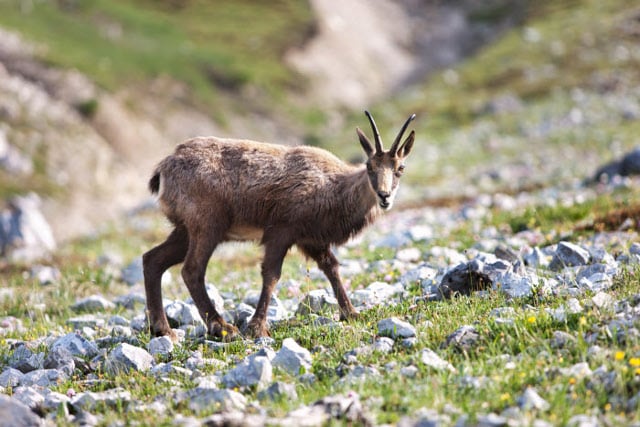 Photo: Nico Schaerer/Swiss Tourism
What?
A hoofed goat-antelope, chamois have smaller, thinner horns than the ibex. However they are equally adept at mountain climbing; nimble and quick, they can leap up to two metres high and run at up to 50km/hr.
Unlike ibex, chamois were not hunted to extinction in Switzerland but came close. Populations recovered in the 20th century and there are now an estimated 90,000 animals across the Alps.
Where?
In summer spot chamois in high alpine meadows above 1,800m across the Swiss Alps, as well as forested areas in the Jura.
Red deer
Photo: Nico Schaerer/Swiss Tourism
What?
A hoofed goat-antelope, chamois have smaller, thinner horns than the ibex. However they are equally adept at mountain climbing; nimble and quick, they can leap up to two metres high and run at up to 50km/hr.
Unlike ibex, chamois were not hunted to extinction in Switzerland but came close. Populations recovered in the 20th century and there are now an estimated 90,000 animals across the Alps.
Where?
In summer spot chamois in high alpine meadows above 1,800m across the Swiss Alps, as well as forested areas in the Jura.
Red deer
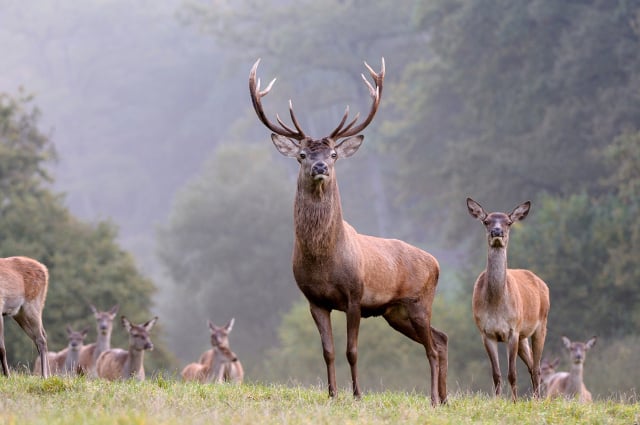 Photo: Prisma/Reinhardt Hoelzl
What?
Named the ‘animal of the year 2017’ by Swiss conservation body Pro Natura, the red deer is Switzerland’s biggest wild animal. There are currently an estimated 35,000 in the country, but it wasn’t always that way, since the red deer was hunted to extinction around 150 years ago. From 1870 this migratory animal started to come back naturally, entering eastern Switzerland from Austria. After an 1875 law limited hunting to certain periods of the year and protected female deer, numbers began to grow.
The antlers of a large stag can weigh as much as 8kg, grown each year over the course of several months. After the annual rut (mating season) in the autumn, they shed their antlers at the end of the winter.
Where?
Deer can be found in much of the Swiss Alps, particularly Graubünden, as well as parts of the Jura. For your best chance, head to the Swiss National Park, where there are hundreds of red deer.
Alpine marmot
Photo: Prisma/Reinhardt Hoelzl
What?
Named the ‘animal of the year 2017’ by Swiss conservation body Pro Natura, the red deer is Switzerland’s biggest wild animal. There are currently an estimated 35,000 in the country, but it wasn’t always that way, since the red deer was hunted to extinction around 150 years ago. From 1870 this migratory animal started to come back naturally, entering eastern Switzerland from Austria. After an 1875 law limited hunting to certain periods of the year and protected female deer, numbers began to grow.
The antlers of a large stag can weigh as much as 8kg, grown each year over the course of several months. After the annual rut (mating season) in the autumn, they shed their antlers at the end of the winter.
Where?
Deer can be found in much of the Swiss Alps, particularly Graubünden, as well as parts of the Jura. For your best chance, head to the Swiss National Park, where there are hundreds of red deer.
Alpine marmot
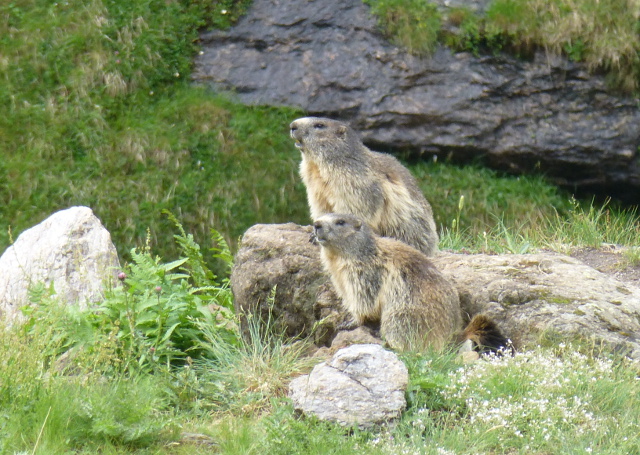 Photo: Caroline Bishop
What?
Resembling larger, fatter squirrels, these funny creatures live in family groups in burrows, and the males mark their territory with their scent. During summer they feast on grass, alpine clover and other plants, fattening themselves up before going into hibernation at the end of September.
Marmots are easy to hear – hikers will often hear their distinctive high-pitched chirp – but less easy to spot as they disappear lightning-quick into their burrows at the slightest hint of danger.
Where?
Marmots can be found all over the Alps living in meadows and subalpine grassland. For a good chance of spotting them walk the marmot trail in Avers, in the canton of Graubünden, or the marmot trail at Sunnegga near Zermatt, an area which is thought to have a particularly large population of marmots.
Golden eagle
Photo: Caroline Bishop
What?
Resembling larger, fatter squirrels, these funny creatures live in family groups in burrows, and the males mark their territory with their scent. During summer they feast on grass, alpine clover and other plants, fattening themselves up before going into hibernation at the end of September.
Marmots are easy to hear – hikers will often hear their distinctive high-pitched chirp – but less easy to spot as they disappear lightning-quick into their burrows at the slightest hint of danger.
Where?
Marmots can be found all over the Alps living in meadows and subalpine grassland. For a good chance of spotting them walk the marmot trail in Avers, in the canton of Graubünden, or the marmot trail at Sunnegga near Zermatt, an area which is thought to have a particularly large population of marmots.
Golden eagle
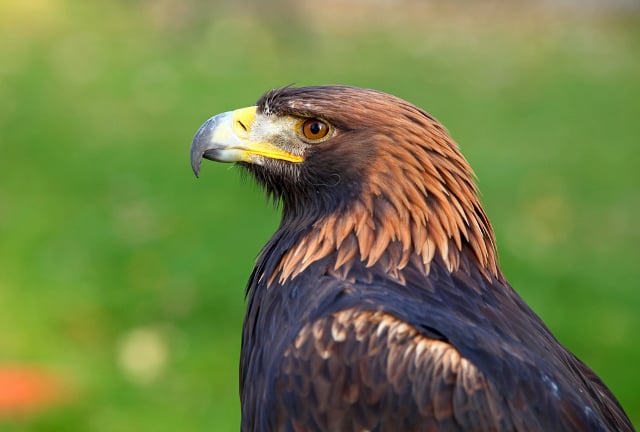 Photo: TTStudio/Depositphotos
What?
With a wingspan of up to 2.2 metres, the so-called ‘king of the air’ is an impressive sight in Swiss skies. This mighty bird of prey managed to survive the period of mass hunting when many other species disappeared from Switzerland, and there are now around 300 breeding pairs in the country.
They enjoy feasting on another of Switzerland’s ‘big five’, the marmot. So if you hear marmots chirping in fright, look up. Golden eagles have no natural predators, but territorial squabbles between themselves mean they can neglect their young, so breeding is not always successful.
Where?
All over the Swiss Alps, though you’re most likely to spot them in winter, according to the Swiss Ornithological Institute. Six pairs live inside the Swiss National Park.
Photo: TTStudio/Depositphotos
What?
With a wingspan of up to 2.2 metres, the so-called ‘king of the air’ is an impressive sight in Swiss skies. This mighty bird of prey managed to survive the period of mass hunting when many other species disappeared from Switzerland, and there are now around 300 breeding pairs in the country.
They enjoy feasting on another of Switzerland’s ‘big five’, the marmot. So if you hear marmots chirping in fright, look up. Golden eagles have no natural predators, but territorial squabbles between themselves mean they can neglect their young, so breeding is not always successful.
Where?
All over the Swiss Alps, though you’re most likely to spot them in winter, according to the Swiss Ornithological Institute. Six pairs live inside the Swiss National Park.
Comments
See Also
While most people are familiar with Africa’s ‘big five’ animals, you may not have known that Switzerland has its very own ‘big five’.
Here’s what to look out for, and where to find them.
Ibex

Photo: Martin Maegli/Swiss Tourism
What?
A sort of mountain goat, by the mid 17th century the ibex had been hunted to extinction in Switzerland as their meat and horns were thought to have medicinal properties. Italian king Vittorio Emmanuele III owned a remaining herd but refused all requests from Switzerland to buy some. So in 1906 the Swiss authorities ordered two to be poached from the king’s herd and smuggled across the Swiss border to start a breeding programme. Their offspring were later released into the Swiss National Park.
Both male and female ibex have distinctive horns, though those of a female are slightly smaller. The horns grow a few centimetres a year throughout their whole life, meaning it’s possible to determine how old the animal is by counting the rings on its horns – if you can get close enough, of course.
Where?
There are around 15,000 ibex in Switzerland, mostly in rocky high alpine areas above the treeline. Sure-footed and agile, you might spot them standing on rocky cliffs or negotiating a path that looks impossible.
Chamois

Photo: Nico Schaerer/Swiss Tourism
What?
A hoofed goat-antelope, chamois have smaller, thinner horns than the ibex. However they are equally adept at mountain climbing; nimble and quick, they can leap up to two metres high and run at up to 50km/hr.
Unlike ibex, chamois were not hunted to extinction in Switzerland but came close. Populations recovered in the 20th century and there are now an estimated 90,000 animals across the Alps.
Where?
In summer spot chamois in high alpine meadows above 1,800m across the Swiss Alps, as well as forested areas in the Jura.
Red deer

Photo: Prisma/Reinhardt Hoelzl
What?
Named the ‘animal of the year 2017’ by Swiss conservation body Pro Natura, the red deer is Switzerland’s biggest wild animal. There are currently an estimated 35,000 in the country, but it wasn’t always that way, since the red deer was hunted to extinction around 150 years ago. From 1870 this migratory animal started to come back naturally, entering eastern Switzerland from Austria. After an 1875 law limited hunting to certain periods of the year and protected female deer, numbers began to grow.
The antlers of a large stag can weigh as much as 8kg, grown each year over the course of several months. After the annual rut (mating season) in the autumn, they shed their antlers at the end of the winter.
Where?
Deer can be found in much of the Swiss Alps, particularly Graubünden, as well as parts of the Jura. For your best chance, head to the Swiss National Park, where there are hundreds of red deer.
Alpine marmot

Photo: Caroline Bishop
What?
Resembling larger, fatter squirrels, these funny creatures live in family groups in burrows, and the males mark their territory with their scent. During summer they feast on grass, alpine clover and other plants, fattening themselves up before going into hibernation at the end of September.
Marmots are easy to hear – hikers will often hear their distinctive high-pitched chirp – but less easy to spot as they disappear lightning-quick into their burrows at the slightest hint of danger.
Where?
Marmots can be found all over the Alps living in meadows and subalpine grassland. For a good chance of spotting them walk the marmot trail in Avers, in the canton of Graubünden, or the marmot trail at Sunnegga near Zermatt, an area which is thought to have a particularly large population of marmots.
Golden eagle

Photo: TTStudio/Depositphotos
What?
With a wingspan of up to 2.2 metres, the so-called ‘king of the air’ is an impressive sight in Swiss skies. This mighty bird of prey managed to survive the period of mass hunting when many other species disappeared from Switzerland, and there are now around 300 breeding pairs in the country.
They enjoy feasting on another of Switzerland’s ‘big five’, the marmot. So if you hear marmots chirping in fright, look up. Golden eagles have no natural predators, but territorial squabbles between themselves mean they can neglect their young, so breeding is not always successful.
Where?
All over the Swiss Alps, though you’re most likely to spot them in winter, according to the Swiss Ornithological Institute. Six pairs live inside the Swiss National Park.
Join the conversation in our comments section below. Share your own views and experience and if you have a question or suggestion for our journalists then email us at [email protected].
Please keep comments civil, constructive and on topic – and make sure to read our terms of use before getting involved.
Please log in here to leave a comment.